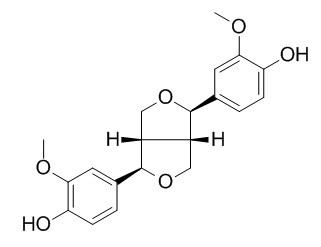(-)-Pinoresinol
Pinoresinol is the precursor of other dietary lignans that are present in whole-grain cereals, legumes, fruits, and other vegetables, PIN can cause an upregulation of the CDK inhibitor p21(WAF1/Cip1) both at mRNA and protein levels; PIN can ameliorate CCl4-induced acute liver injury, and this protection is likely due to anti-oxidative activity and down-regulation of inflammatory mediators through inhibition of NF-kappaB and AP-1. (+)-Pinoresinol possesses fungicidal activities and therapeutic potential as an antifungal agent for the treatment of fungal infectious diseases in humans.
Inquire / Order:
manager@chemfaces.com
Technical Inquiries:
service@chemfaces.com
Tel:
+86-27-84237783
Fax:
+86-27-84254680
Address:
1 Building, No. 83, CheCheng Rd., Wuhan Economic and Technological Development Zone, Wuhan, Hubei 430056, PRC
Providing storage is as stated on the product vial and the vial is kept tightly sealed, the product can be stored for up to
24 months(2-8C).
Wherever possible, you should prepare and use solutions on the same day. However, if you need to make up stock solutions in advance, we recommend that you store the solution as aliquots in tightly sealed vials at -20C. Generally, these will be useable for up to two weeks. Before use, and prior to opening the vial we recommend that you allow your product to equilibrate to room temperature for at least 1 hour.
Need more advice on solubility, usage and handling? Please email to: service@chemfaces.com
The packaging of the product may have turned upside down during transportation, resulting in the natural compounds adhering to the neck or cap of the vial. take the vial out of its packaging and gently shake to let the compounds fall to the bottom of the vial. for liquid products, centrifuge at 200-500 RPM to gather the liquid at the bottom of the vial. try to avoid loss or contamination during handling.
Mol Pharmacol.2021, 99(2):163-174.
Nutrients2020, 12(2):488
GENENCELL2023, 25:4356740
Food Analytical Methods2017, 10:3225-3234
Environ Toxicol.2021, 36(9):1848-1856.
Evid Based Complement Alternat Med.2019, 2019:2135351
J Biochem Mol Toxicol.2025, 39(8):e70416.
Bioinformatics 2024, 586957
bioRxiv - Biochemistry2023, 548213.
Phytochemistry Letters2021, 43:80-87.
Related and Featured Products
Molecules, 2010, 15(5):3507-16.
Antifungal effect of (+)-pinoresinol isolated from Sambucus williamsii.[Pubmed:
20657496]
METHODS AND RESULTS:
In this study, we investigated the antifungal activity and mechanism of action of (+)-pinoresinol, a biphenolic compound isolated from the herb Sambucus williamsii,used in traditional medicine. (+)-Pinoresinol displays potent antifungal properties without hemolytic effects on human erythrocytes. To understand the antifungal mechanism of (+)-pinoresinol, we conducted fluorescence experiments on the human pathogen Candida albicans. Fluorescence analysis using 1,6-diphenyl-1,3,5-hexatriene (DPH) indicated that the (+)-pinoresinol caused damage to the fungal plasma membrane. This result was confirmed by using rhodamine-labeled giant unilamellar vesicle (GUV) experiments.
CONCLUSIONS:
Therefore, the present study indicates that (+)-pinoresinol possesses fungicidal activities and therapeutic potential as an antifungal agent for the treatment of fungal infectious diseases in humans.
J. Pharmacol. Sci. 2010,112(1):105-12.
Hepatoprotective effect of pinoresinol on carbon tetrachloride-induced hepatic damage in mice.[Pubmed:
20093790]
Forsythiae Fructus is known to have diuretic, anti-bacterial, and anti-inflammatory activities. This study examined the hepatoprotective effects of pinoresinol, a lignan isolated from Forsythiae Fructus, against carbon tetrachloride (CCl(4))-induced liver injury.
METHODS AND RESULTS:
Mice were treated intraperitoneally with vehicle or pinoresinol (25, 50, 100, and 200 mg/kg) 30 min before and 2 h after CCl4 (20 microl/kg) injection. In the vehicle-treated CCl(4 )group, serum aminotransferase activities were significantly increased 24 h after CCl4 injection, and these increases were attenuated by pinoresinol at all doses. Hepatic glutathione contents were significantly decreased and lipid peroxidation was increased after CCl4 treatment. These changes were attenuated by 50 and 100 mg/kg of pinoresinol. The levels of protein and mRNA expression of inflammatory mediators, including tumor necrosis factor-alpha, inducible nitric oxide synthase, and cyclooxygenase-2, were significantly increased after CCl4 injection; and these increases were attenuated by pinoresinol. Nuclear translocation of nuclear factor-kappaB (NF-kappaB) and phosphorylation of c-Jun, one of the components of activating protein 1 (AP-1), were inhibited by pinoresinol.
CONCLUSIONS:
Our results suggest that pinoresinol ameliorates CCl4)-induced acute liver injury, and this protection is likely due to anti-oxidative activity and down-regulation of inflammatory mediators through inhibition of NF-kappaB and AP-1.



